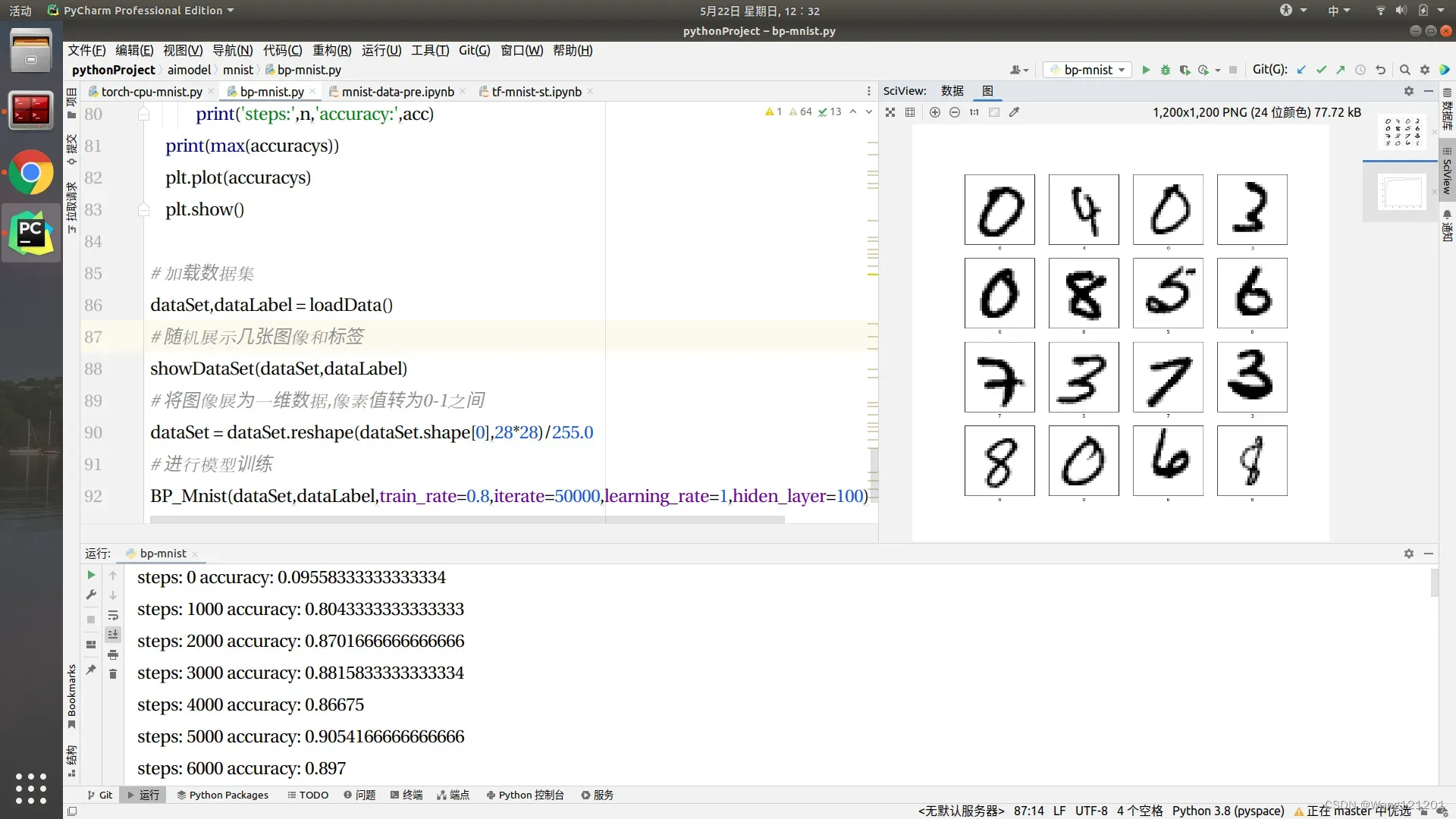使用numpy实现BP神经网络,并对MNIST数据集进行测试.
模型说明
直接读取本地文件获得数据集
数据集使用包含60000个图像的文件,可以设置
单隐层神经网络,可以调整隐层神经元个数
激活函数:sigmoid
更新模型参数的原理可以参考西瓜书
初始化模型参数权重:参数正态分布
没有考虑偏置,西瓜书里面的阈值
import matplotlib.pyplot as plt
import numpy as np
import os
# 激活函数
def sigmoid(x):
return 1/(1+np.exp(-x))
# 随机显示数据集图像和标签
def showDataSet(dataSet,dataLabel):
plt.figure(figsize=(12,12))
for i in range(16):
index = np.random.randint(0,len(dataSet))
plt.subplot(4,4,i+1)
plt.xticks([])
plt.yticks([])
plt.grid(False)
plt.imshow(dataSet[index], cmap=plt.cm.binary)
plt.xlabel(dataLabel[index])
plt.show()
def loadData(path = './data/MNIST/raw'):
# 读取数据分别对应60000和10000的数据集
# dataImg = np.fromfile(open(os.path.join(path, 't10k-images-idx3-ubyte')),dtype=np.uint8)
# dataLabel = np.fromfile(open(os.path.join(path, 't10k-labels-idx1-ubyte')),dtype=np.uint8)
dataImg = np.fromfile(open(os.path.join(path, 'train-images-idx3-ubyte')),dtype=np.uint8)
dataLabel = np.fromfile(open(os.path.join(path, 'train-labels-idx1-ubyte')),dtype=np.uint8)
# 前几位数据无意义,对数据类型进行转换
dataLabel = dataLabel[8:].astype(np.int)
dataImg = dataImg[16:].reshape(60000,28,28).astype(np.int)
return dataImg,dataLabel
def BP_Mnist(dataSet,dataLabel, train_rate = 0.8,iterate = 50000, learning_rate = 2 ,hiden_layer = 100):
# 根据train_rate对训练数据和测试数据进行划分
split = [train_rate * len(dataSet), train_rate * len(dataLabel)]
trainSet, testSet = dataSet[:int(split[0])], dataSet[int(split[1]):]
trainLabel, testLabel = dataLabel[:int(split[0])], dataLabel[int(split[1]):]
# 输出的大小
labelsize = len(set(testLabel))
# 输入维度28*28,输出维度10,即10个数字
input_layer = len(dataSet[0])
out_layer = labelsize
# 标签二值化,参考sklearn的函数,直接使用n维单位矩阵就可以
label_code = np.identity(labelsize, dtype=int)
# 初始化模型权重,不同的初始化方式对模型收敛的速度和收敛的效果影响很大
# hiden_Weight = np.random.randn(hiden_layer,input_layer)
# out_Weight = np.random.randn(out_layer, hiden_layer)
hiden_Weight = np.random.randn(hiden_layer,input_layer)/np.sqrt(hiden_layer/2.0)
out_Weight = np.random.randn(out_layer, hiden_layer)/np.sqrt(out_layer/2.0)
# 记录模型的准确度
accuracys=[]
for n in range(iterate):
# 数据集中随机选择一个作为模型输入
index = np.random.randint(0,len(dataSet))
xinput = np.array(dataSet[index])
# 将模型的输出转为二值标签即对应的10个输出
yout = np.array(label_code[dataLabel[index]])
# 计算隐藏层输出
hiden = sigmoid(np.dot(xinput,hiden_Weight.T))
# 计算输出层的输出
out = sigmoid(np.dot(hiden,out_Weight.T))
# 最小化损失函数
# error = sum((out-yout)**2)
# 更新模型参数
g_j = out*(1-out)*(yout-out)
e_h = hiden*(1-hiden)*(g_j.dot(out_Weight))
hiden_Weight += learning_rate*e_h.reshape(-1,1)*xinput
out_Weight += learning_rate*g_j.reshape(-1,1)*hiden
# 训练1000次,计算一次模型准确度
if n%1000==0:
# 预测的模型输出
pre_hide = sigmoid(np.dot(testSet,hiden_Weight.T))
pr_out = sigmoid(np.dot(pre_hide,out_Weight.T))
predictions = np.argmax(pr_out,axis=1)
# 模型准确度
acc = np.mean(np.equal(predictions,testLabel))
accuracys.append(acc)
print('steps:',n,'accuracy:',acc)
print('max accuracy: ',max(accuracys))
plt.plot(accuracys)
plt.show()
# 加载数据集
dataSet,dataLabel = loadData()
# 随机展示几张图像和标签
showDataSet(dataSet,dataLabel)
# 将图像展为一维数据,像素值转为0-1之间
dataSet = dataSet.reshape(dataSet.shape[0],28*28)/255.0
# 进行模型训练
np.random.seed(0)
BP_Mnist(dataSet,dataLabel,train_rate=0.8,iterate=50000,learning_rate=1,hiden_layer=100)
运行结果


文章出处登录后可见!
已经登录?立即刷新
